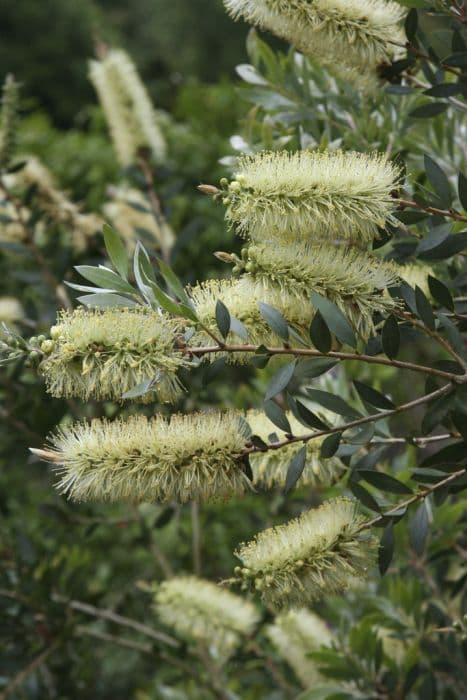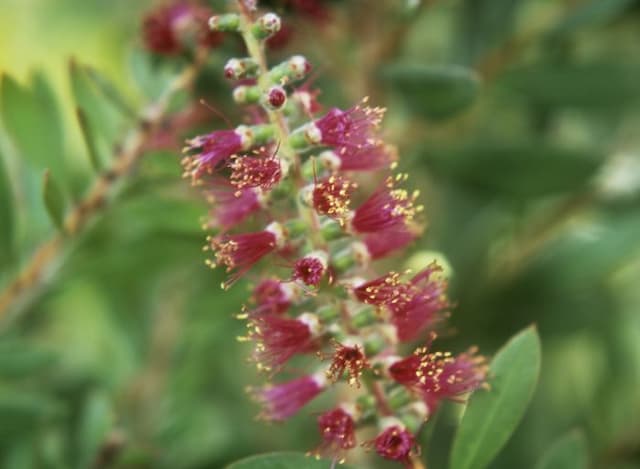Chilean myrtle Luma apiculata

ABOUT
The Luma apiculata, commonly known as the Chilean myrtle, is a visually striking plant with several distinct features, making it a favorite among garden enthusiasts. The plant is adorned with a smooth, multi-toned bark that peels away in cinnamon and cream hues, creating a patchwork of colors that is particularly attractive. This elegant bark provides a beautiful contrast to its evergreen foliage. The leaves of the Chilean myrtle are small, glossy, and oval-shaped with a dark green hue on the upper side and a lighter green on the underside. When crushed, they release a fragrant, aromatic scent. During blooming season, the Chilean myrtle produces an abundance of small, star-shaped white flowers that cluster densely on the branches, exhaling a delicate, sweet fragrance that attracts pollinators. Following the flowering period, it bears purple-black, round berries. These fruits are both a visual delight and a food source for local birds and wildlife. The plant’s overall appearance is lush and vibrant, with a dense canopy of leaves and a profusion of flowers and fruits that offer year-round interest. With its elegant bark, fragrant leaves, and showy blooms, the Chilean myrtle is a valuable addition to any garden, offering beauty and attracting a diversity of wildlife without requiring explicit detail of its dimensions.
About this plant
 Names
NamesFamily
Myrtaceae.
Synonyms
Chilean Myrtle, Arrayan, Temu.
Common names
Eugenia apiculata, Myrtus luma, Myrceugenia apiculata, Luma chequen, Myrtus chequen, Eugenia chequen, Myrceugenia chequen, Eugenia luma.
 Toxicity
ToxicityTo humans
The Luma apiculata, commonly known as the Chilean myrtle, is not generally considered toxic to humans. However, as with many plants, sensitivity can vary among individuals, and some people might experience mild stomach upset if parts of the plant are ingested. There are no widely recognized severe toxic effects from consuming the Chilean myrtle for humans.
To pets
The Chilean myrtle, or Luma apiculata, is also not known to be toxic to pets. Ingesting parts of the plant may cause mild gastrointestinal upset in some animals, similar to the potential reaction in humans, but it is not typically associated with serious or life-threatening symptoms of poisoning in pets. Owners should still prevent pets from eating plants, as individual reactions can vary.
 Characteristics
CharacteristicsLife cycle
Perennials
Foliage type
Evergreen
Color of leaves
Green
Flower color
White
Height
10-15 feet (3-4.5 meters)
Spread
4-6 feet (1.2-1.8 meters)
Plant type
Tree
Hardiness zones
8
Native area
Chile Argentina
Benefits
 General Benefits
General Benefits- Ornamental value: Luma apiculata, commonly known as the Chilean myrtle, is an aesthetically pleasing plant often used in gardens and landscapes for its decorative, evergreen foliage and attractive bark.
- Wildlife habitat: It provides food and shelter for various species of birds and insects, which are attracted to its flowers and small berry-like fruits.
- Drought tolerance: Once established, the Chilean myrtle is relatively drought-resistant, making it suitable for xeriscaping and low-water-use gardens.
- Wind resistance: Its sturdy structure allows it to endure windy conditions, which is beneficial for coastal regions or areas with frequent strong winds.
- Shade provider: As a tree, it can offer shade in gardens or urban environments, creating cooler areas that can improve comfort during hot weather.
- Erosion control: The root system of Luma apiculata can help stabilize soil on slopes and prevent erosion.
 Medical Properties
Medical PropertiesThis plant is not used for medical purposes.
 Air-purifying Qualities
Air-purifying QualitiesThis plant is not specifically known for air purifying qualities.
 Other Uses
Other Uses- Luma apiculata, commonly known as Chilean myrtle, can be used as a natural dye for fabrics, providing a range of colors from greens to browns depending on the mordant used.
- In woodworking, the hard, dense wood of the Chilean myrtle is valued for crafting fine furniture and intricate carvings.
- Chilean myrtle's wood is also suitable for making musical instruments, offering good acoustic properties for guitars and wind instruments.
- The aromatic leaves of the Chilean myrtle can be used as a natural insect repellent when crushed and scattered in outdoor areas.
- Its branches and foliage are often used in floristry for creating ornamental wreaths and as filler in floral arrangements.
- Chilean myrtle can be planted as a windbreak or hedge in coastal areas, thanks to its resistance to wind and salt spray.
- The bark of the Chilean myrtle has been traditionally used to tan leather, imbuing it with a distinct color and durability.
- During festive occasions, the flowers of the Chilean myrtle can be used for decoration due to their attractive appearance and pleasant fragrance.
- In the culinary field, the slightly aromatic leaves can sometimes be used as a flavoring agent in cooking, similar to the use of bay leaves.
- The tree's dense growth habit makes it suitable for use in topiary, allowing gardeners to shape it into various forms for landscape design.
Interesting Facts
 Feng Shui
Feng ShuiThe Arrayan is not used in Feng Shui practice.
 Zodiac Sign Compitability
Zodiac Sign CompitabilityThe Arrayan is not used in astrology practice.
 Plant Symbolism
Plant Symbolism- Resilience: Luma apiculata, commonly known as the Chilean myrtle, thrives in a variety of soil types and weather conditions, symbolizing the ability to endure and adapt to changing environments.
- Elegance: With its attractive, cinnamon-colored bark and delicate white flowers, the Chilean myrtle represents grace and beauty in the plant world.
- Renewal: The plant's evergreen nature and tendency to regenerate after fires or damage signify new beginnings and the renewal of life.
- Healing: Historically, indigenous peoples have used various parts of the Chilean myrtle for medicinal purposes, symbolizing health and healing.
- Protection: The dense foliage and hardy nature of the Chilean myrtle suggest a symbol of protection and shelter.
 Water
WaterThe Chilean myrtle, also known as Luma apiculata, requires consistent moisture, particularly during the growing season. It should be watered deeply once a week, ensuring that the soil is moist but not waterlogged. In dry or hot climates, you may need to water more frequently, perhaps twice a week. The amount of water should be approximately one to two gallons per watering session, depending on the size and maturity of the plant as well as the climate conditions.
 Light
LightThe Chilean myrtle thrives best in full sun to partial shade. A spot that receives at least 6 to 8 hours of direct sunlight a day is ideal, but it should be protected from harsh, afternoon sun if located in an area with extremely hot summers. Filtered sunlight or dappled shade works well too, especially in the hottest parts of the day.
 Temperature
TemperatureThe ideal temperature range for the Chilean myrtle is between 50°F and 70°F. It can tolerate temperatures down to about 20°F, making it suitable for growth in USDA zones 7b to 10b. It is not frost tender but should be protected from extreme cold snaps that fall below the minimum tolerance level.
 Pruning
PruningPruning the Chilean myrtle is important for shaping the plant and encouraging new growth. It should be pruned in late winter or early spring before new leaves emerge. Remove any dead or damaged branches and thin out the plant to ensure good air circulation. Pruning can also be done after the plant flowers to maintain a desired size or shape.
 Cleaning
CleaningAs needed
 Soil
SoilThe best soil mix for the Chilean Myrtle, also known as Luma apiculata, should be well-draining with plenty of organic matter, such as a mix of loam, peat, and sharp sand. A slightly acidic to neutral pH of 6.0 to 7.0 is ideal for this plant.
 Repotting
RepottingThe Chilean Myrtle should be repotted every 2 to 3 years. Younger plants may need to be repotted more frequently, every 1 to 2 years, until they reach maturity.
 Humidity & Misting
Humidity & MistingThe Chilean Myrtle thrives in moderate to high humidity levels, ideally around 50-60%. Avoid environments that are too dry, as this can affect the plant's health.
 Suitable locations
Suitable locationsIndoor
Place Chilean Myrtle in bright light, ensure moderate humidity.
Outdoor
Chilean Myrtle thrives in full sun to part shade, shelter from harsh elements.
Hardiness zone
7-10 USDA
 Life cycle
Life cycleThe life cycle of the Chilean myrtle (Luma apiculata) begins with seed germination, which requires stratification to break dormancy. Once sprouted, the seedlings grow into young saplings, developing a characteristic smooth, cinnamon-colored bark. As the plant matures, it enters a vegetative stage where it forms dense foliage with small, leathery leaves. Over time, the Chilean myrtle reaches the flowering stage, producing clusters of white, aromatic flowers, mainly in the summer. After pollination, typically by bees, the flowers develop into purple or black berries that attract birds, which aid in seed dispersal. The plant can live for many years, growing into a small to medium-sized tree or shrub, playing a role in its ecosystem by providing habitat and food to wildlife.
 Propogation
PropogationPropogation time
Spring-Early Summer
The Chilean myrtle, commonly known as Luma apiculata, is most effectively propagated via semi-hardwood cuttings. This process typically takes place during the summer months when the current season’s growth has matured enough to have semi-hardwood consistency. To propagate by cuttings, a gardener should select a healthy stem and make a cut to include several leaf nodes. The cutting should be about 6 inches (approximately 15 centimeters) long. The lower leaves are removed, and the cut end may be dipped into a rooting hormone to encourage root development. Then, the cutting is placed in a well-draining growing medium and kept at consistent humidity and warmth. Rooting usually occurs within a few weeks, after which the cuttings can eventually be transplanted to their permanent location.







![New Zealand myrtle [Black Pearl]](/_next/image?url=https%3A%2F%2Fplants-admin.emdemapps.com%2Fimages%2Fplants%2F%2Fimages%2F604b53688d37e.png&w=640&q=75)

